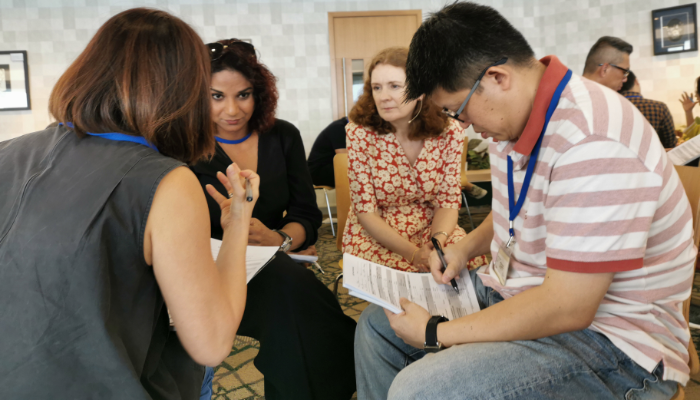Since the technology exists to enable people to ‘meet’ in groups, break into smaller groups, look at slides, write on whiteboards and exchange messages outside of the main activity of the session, it’s not surprising that the possibility of conducting group training online has arisen.
The question is, why do we need to be together? And why don’t we?
The benefits of doing training/coaching online
- We know from the increased use of video meeting technology during the ‘Lockdown’ that virtual meetings can be shorter, more efficient and more focused than the typical meeting carried out face-to-face. These benefits are especially noticed when meeting participants know each other well.
- In addition to virtual workshops, an online development experience can include e-learning, done where and when it suits the learner.
- Since a lot of leadership must now take place in virtual environments, it makes sense to do the learning in the same environment.
- One-to-one coaching can work well in a video-conference – some clients report that they feel more able to express any difficulties when they are in the comfort of their own home.
- Virtual workshops can potentially accommodate larger cohorts of learners and there is much less administrative time required to arrange a virtual event compared to the work of organising an ‘in person’ workshop or training programme.
- Importantly, the Covid-19 risk with virtual events is zero. Nobody has to leave home.
In summary, there are lots of great reasons why it makes sense to do our leadership development programmes on-line. And yet…
The downsides of virtual training
Video-conferencing is tiring. Much more tiring than being physically present with other people. This drain on energy comes from a variety of factors including:
- The reduced view of colleagues means that it needs greater focus of attention to pick up and process the non-verbal cues.
- Because we can only see heads and shoulders, we may feel that our minds are together but our bodies know that we’re not. This creates cognitive stress, meaning we can’t relax and become fully immersed in the conversation.
- Seeing yourself on the screen is also a source of stress. It’s hard to ignore your own image and most people are constantly monitoring their appearance, checking they look good or worrying that they don’t. At best it’s a distraction, at worst it’s another stressor.
- This extra stress means that there are more misunderstandings and more negative comments and feedback on a virtual meeting.
- In a virtual gathering you can’t make eye-contact. You can’t see who’s watching whom. You can’t pick up the subtle cues that let us know whose turn it is to speak. We can cope when we know everyone, but with new colleagues we fail to experience the warmth and trust that leads to effective working relationships.
- The human brain cannot detect latency in the technology of anything up to 100ms. Data transmitted under such conditions is perceived as instantaneous. However, if your internet connection is slow and the latency increases above 100ms, we begin to be aware of it and this has a negative effect on performance. Delays of more than 1 second will have a negative impact on relationships – the other person is perceived as less trustworthy if there is a delay in the communication of 1s or more.
- Because of the heavy reliance on video-conferencing during lockdown, many people already have a lot of negative associations with this medium. It’s become, for many people, their least-favourite meeting room. The one with the distracting background noise, bad lighting and poor acoustics. The one where you get to see how lovely your boss’s home is and hope nobody can see the laundry drying behind you in your micro-flat. More stress.
The above drawbacks apply to all virtual meetings, not just training workshops. When it comes to training there are additional considerations:
- If a person is stressed by the virtual medium, their brain will trip into ‘threat’ mode, where their field of vision is reduced, short-term memory impaired and mood depressed into a generalised feeling of ‘gloom and doom’. This is definitely not a good state for learning.
- Leadership development involves raising self-awareness and sometimes can include dealing with old emotional baggage. Because of the on-off nature of virtual events, it can be hard for trainers/coaches to spot the signs that someone is brooding about something that happened earlier in the day, and even harder to offer the necessary support.
- Some of our content is hard to teach through a virtual medium because it involves physical movement.
- Our leadership development programmes include multiple days of workshop time. Clearly, we would not expect to replicate that timetable. We would plan shorter sessions and deliver some content by other means. However, in whatever way that time is divided into shorter sessions, there are going to be repeated opportunities for ‘real life’ to intrude on the learning process. This leads to imperfect consolidation of the learning and reduces the application of what has been learned.
- The lack of separation between different elements of life is another source of stress for people involved in lots of virtual meetings. They have lost the feeling of moving from one context to another and the change of pace that goes with each. Since all learning is context-dependent, we need to think carefully about how we set up the context for learning.
Now, let’s weigh up these disadvantages with the advantages of getting people together physically to do leadership development:
The benefits of being physically together for training
- Part of the purpose of a leadership development programme is to create lasting and meaningful relationships between participants, much of which comes from having a shared experience. The value of being in the same place, eating the same food, getting distracted by the same things and seeing each other having moments of great insight is what creates the bond that drives successful business.
- In a global organisation, visiting another country and exploring new places together not only strengthens professional relationships, it also builds cultural understanding and an appreciation of the challenges faced in different parts of the world.
- When participants come together in the same location, they tend to allow more ‘transition time’ between previous commitments and the workshop. This ensures they are mentally ready to engage.
- If we are physically together, the delivery team can manage the environment. This means the participants only have to manage their own presence. We can remove most of the stress and keep everyone in ‘reward’ mode, where the brain is open, receptive and creative. In ‘reward’ mode the memory functions properly and it’s easy to make connections with new ideas. This in turn means that what is learned is properly consolidated into long-term memory and becomes available for implementation.
- And of course, if we are physically together, none of the problems associated with virtual environment apply.
But it isn’t perfect…
The downside of being physically together for training
- Getting everyone together in the same place is costly. Venue hire, travel costs, accommodation and meals can add up to a substantial bill.
- In the current level of alert for Covid-19, using public transport may not be appealing to participants and a 1m social distancing requirement could place a degree of stress on all concerned, even if all appropriate precautions are in place.
What to do?
Finally, deciding how to deliver an effective Leadership Development Programme will involve a number of factors. To get the best of all worlds, I would recommend it includes:
- Kick-off meeting via video-conference.
- E-learning of introductory materials.
- Workshops delivered ‘in person’ when the Covid-19 risk can be managed appropriately.
- Coaching conducted via video-conference or in-person, to suit the individuals and the logistics.
- Regular ‘check-in’ meetings via video-conference.
By using all of the available options we can deliver a programme that truly meets the needs of our leaders and their teams, today.
Sources:
The reason Zoom calls drain your energy – By Manyu Jiang 22nd April 2020
The psychological impact of video calls – by H Locke, UX Collective
How Fast is Realtime? Human Perception and Technology – PubNub
The SCARF Model – David Rock






